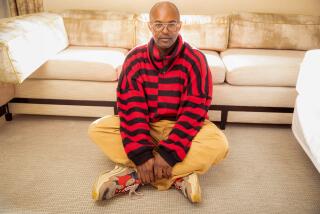OPERA PREMIERE SET AT UCSD
- Share via
LA JOLLA — As a young man in Chicago in the late 1960s, Anthony Braxton’s dreams were similar to those of other aspiring jazz musicians--to emulate the “swingsters” of the day and to become a commercial success.
But commercial appeal usually means that an artist must abandon his creativity and follow the rules handed down by the music industry. So Braxton followed his own course and has made uncompromised music based on his philosophy of life and his visions for the future.
His latest work is an opera titled “Trillium,” which will have its world premiere Saturday night and Sunday afternoon at UC San Diego’s Mandeville Auditorium.
Commissioned to commemorate the 10th anniversary of the university’s Mandeville Center, “Trillium” is not a traditional opera. The 75-minute performance combines elements of music, dance and drama, and will feature a 40-member orchestra, a chorus and six principal singers performing with six improvising instrumentalists.
Continuation of Work
Braxton--a Regents lecturer at UC San Diego--said “Trillium” is a continuation of musical work he has been doing for the past 20 years. The libretto is arranged in a series of episodes and is more an expression of Braxton’s philosophies of life than an operatic narrative.
According to Braxton, the opera has “no subject matter or story matter in the conventional sense,” but the six main characters address many issues regarding the state of human existence. Rather than focusing on issues, “Trillium” centers on how the characters interpret issues. The work seeks to examine the past and present in order to predict the future, Braxton said.
A quiet, subdued man whose round glasses make him seem quite professorial, Braxton’s views on music are on a complex, highly theoretical level. In addition to using conventional forms of harmony and melody, Braxton blends complex rhythms and harmonic structures not usually found in music from Western culture.
Braxton says he wants to create a “new world music” bound only by the creativity of the composer. Critics have called his work clinical and insensitive. But, Braxton said, anyone willing to put aside the standards that govern music in Western can understand what he is trying to accomplish.
‘See Music as Separate’
Westerners “see music as separate from dance, as separate from drama and as separate from sculpture,” he said.
The ancient Egyptians, Asians and Europeans were aware of the relationship between all art forms, Braxton said.
By examining those cultures, “We can see a more unified context of creativity and the science of the music and its spiritual context,” he said. “By understanding world culture, we can begin to inspire excellence and spiritual consciousness.”
Braxton hopes that his music will help “unify humanity based on similarities, rather than our present fascination with what we think are differences.”
Music or Physics?
When Braxton discusses his music, his use of such terms as “functionalism” and “vibrational dynamics” might make one think the subject was physics. Braxton’s compositions, which are represented by mathematical diagrams instead of titles, are largely unpopular with critics.
Braxton says, however, that his music is not mechanical. It displays his compassion and hope for an art form that will serve as a force for positive change, he said, adding that he blends music with science because the two disciplines are closely related.
“I’m interested in trying out new systems in an attempt to discover the basis for a new (musical) life,” he said. “I’m interested in tapping anything that hints of that vibration but hasn’t been there before.”
Braxton, who plays several instruments, was born in Chicago in 1945. He found his musical direction in the 1960s by listening to the works of saxophonists John Coltrane and Ornette Coleman and pianist Cecil Taylor.
Visionaries Called Extreme
These jazz visionaries were also called extremists because they used complex harmonies and unconventional combinations of instruments. Braxton was also influenced by such composers as John Cage and West German composer Karlheinz Stockhausen.
In the late 1960s, Braxton helped form the “free jazz” group, the Art Ensemble of Chicago. He traveled with the group to France in 1969 and remained there for several years to continue developing his music.
In 1971, he performed in Paris with pianist Chick Corea and the group Circle. After Circle disbanded, Braxton spent the next 10 years crisscrossing Europe and the United States working with various groups and as a soloist. By the mid-1970s, Braxton’s music had attracted a substantial following in Europe and America.
Braxton, who now lives in New Haven, Conn., believes that the warm reception “Trillium” is receiving from UC San Diego students and faculty members shows that interest in his music is growing.
‘People Reaching Out’
“I think people are more open to creative music than what we are generally told,” he said. “I think that people all over this country are reaching out for information and creativity that seeks to be about something, as opposed to information dealing with how to make some money.
“I believe the new, expanded options in creativity can be inclusive and attract a broader spectrum of people.”
Braxton hopes that his music will inspire young people in music and in other disciplines to sustain their creativity energy.
“I believe that we can help the young people in this culture by trying to emphasize positive role models,” he said. “It’s important to do the best you can and not allow any negative forces to stop your growth.”
Although Braxton’s music is not receiving the critical acclaim he thinks it deserves, he is not bitter.
“Music is alive and well,” he said, “even if it’s not talking about sex and someone’s boo-boo.”
More to Read
The biggest entertainment stories
Get our big stories about Hollywood, film, television, music, arts, culture and more right in your inbox as soon as they publish.
You may occasionally receive promotional content from the Los Angeles Times.










